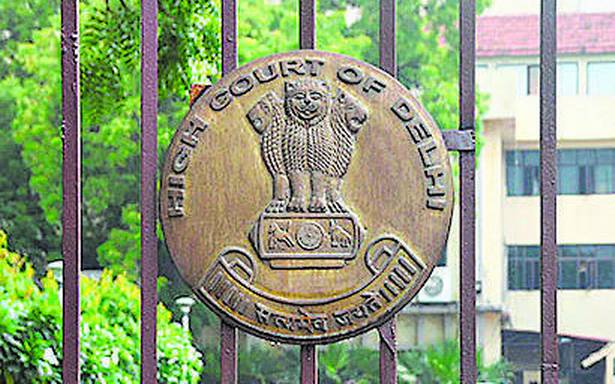Court rejects bail plea of man arrested for constable’s death.
The Delhi High Court has rejected the bail petition of a man arrested in connection with the death of a head constable during the northeast Delhi riots last year, noting that the incident was a result of a “pre-planned and pre-meditated conspiracy to disturb law and order in the city”.
Justice Subramonium Prasad, while dismissing the bail plea of Mohd. Ibrahim, who was seen on numerous CCTV footages wearing a skull cap, black Nehru jacket and salwar-kurta and with a sword in his hand on multiple locations around Chand Bagh area.
Also read: Delhi riots: court pulls up police for ‘callous’ probe
Justice Prasad said even though Mr. Ibrahim could not be seen at the ‘scene of crime’, he clearly was part of the mob for the sole reason that he had consciously travelled 1.6 km away from his neighbourhood with a sword, which could only be used to incite violence and inflict damage.
“The riots which shook the National Capital of the country in February 2020 evidently did not take place in a spur of the moment, and the conduct of the protesters who are present in the video footage, which has been placed on record by the prosecution visibly portrays that it was a calculated attempt to dislocate the functioning of the government as well as to disrupt the normal life of the people in the city,” the court remarked.
The systematic disconnection and destruction of CCTV cameras also confirmed the existence of a pre-planned and pre-meditated conspiracy to disturb law and order in the city, Justice Prasad said. “This is also evident from the fact that innumerable rioters ruthlessly descended with sticks, ‘dandas’, bats etc. upon a hopelessly outnumbered cohort of police officials”.
Protest against CAA
The case relates to an FIR filed in connection with a protest against the Citizenship (Amendment) Act (CAA), 2019 that had been taking place for 1.5 months prior to the incident at Khajuri Square to Loni Circle at Wazirabad Road, Chand Bagh, by the Muslim community.
Also read: Delhi riots: Court drops arson charges against 10, says police covering flaw
On February 24, 2020, around 1.00 p.m. the protesters mobilised near the Chand Bagh area and 25 Futa Road, and moved towards the Main Wazirabad Road. When police attempted to convince them to not move forward, the protesters carrying sticks, baseball sticks, iron rods and stones turned violent.
Some people in the crowd started pelting stones at the police officials, and beat them as well as other passers-by. The FIR stated that ACP Gokalpuri, head constable Ratan Lal and DCP Shahdara Amit Kumar were beaten with sticks and stones, and as a result, they fell down and suffered grievous head injuries. Later, the head constable died of a bullet injury.
Died of gunshot injury
Mr. Ibrahim’s counsel argued that as per the injury report, which was a part and parcel of the charge sheet, the death of the head constable was due to a gunshot injury and the same was possibly fired from the gun of a police official. The death had not been caused by the sword which was carried by Mr. Ibrahim, he said.
Additional Solicitor General S.V. Raju, representing the Delhi Police, said the absence of an accused from a video did not translate into absence of the accused from the scene of crime. Identification of an accused in videography was a Herculean task, he noted.
After perusing the material on record, the court said Mr. Ibrahim had been clearly identified on multiple CCTV footages, carrying a sword and instigating the crowd.
The clinching evidence that tilted this court towards prolonging the incarceration of Mr. Ibrahim was the fact that the weapon which was being carried by him was capable of causing grievous injuries and/or death, and was prima facie a dangerous weapon, Justice Prasad noted.
Bail for another arrested
On Monday, in a separate decision on the same FIR, the court granted bail to Mohd. Saleem Khan, who was arrested on March 11, 2020. He was seen turning away a CCTV camera with the aid of a wiper.
Senior advocate Salman Khurshid, representing Mr. Khan, argued that his client had been falsely implicated in the FIR and that there was nothing on record which showed that Mr. Khan was a part of a mob or present at the scene of crime (SOC).
Justice Prasad said, “A perusal of the material on record has revealed to the court that the video footage wherein the petitioner [Mr. Khan] is seen does not indicate whether the petitioner was a part of the unlawful assembly at the SOC”.
Even though Mr. Khan could be seen dislocating a CCTV camera and inciting the crowd, the court said whether he was a part of the conspiracy or not could be ascertained only after evidence was filed.
The usage of a wiper to turn away the CCTV camera implied that Mr. Khan may have been in the knowhow of the impending riots, Justice Prasad observed. The extent to which the charge could be added against him could not be deconstructed by this court at this point and was a matter of trial, he added.


